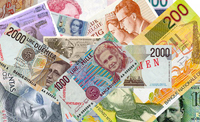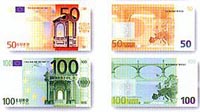::::::::::::::::::
::::::::::::::::::
::::::::::::::::::

In
January 2000 the currencies of 12 European countries were substituted
by a new, unified one, the Euro. The unification of the currency as an
economic enterprise also had to unify the iconography representing the
12 countries. Writers, queens, painters and scientists gave way to contemporary
roman accueducts and modern greek temples. All and none in one.
In
spite of the simplicity of the new design,
vibrant colors identify each bill. Purples, oranges, yellows and greens
are now the iconographic elements of the old continent. The Color
of Money reaches for those colors to create a new language of commerce,
where the user makes paintings with the color scheme of each bill. Type
a number larger than 5 and the value of such number will be represented
by the colors of the bills. The system follows a logical calculation of
the best combination of bills when dealing with larg numbers.
::::::::::::::::::
::::::::::::::::::
::::::::::::::::::

::::::::::::::::::
::::::::::::::::::
::::::::::::::::::
